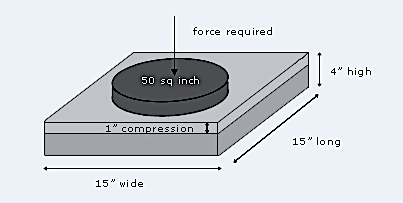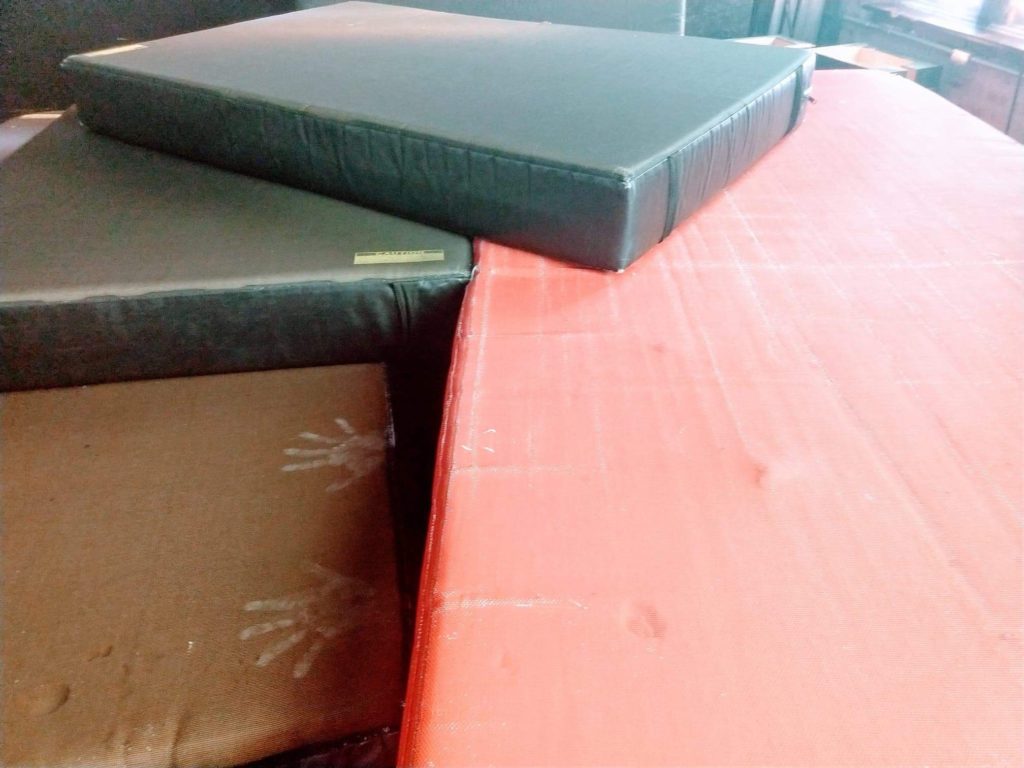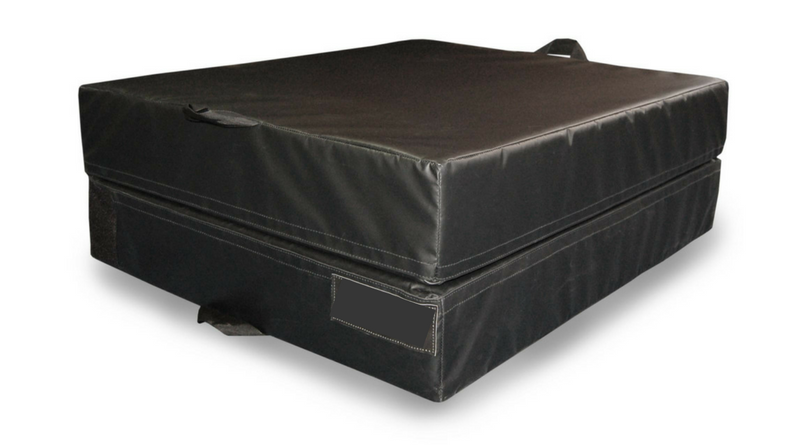Yes Virginia, Professional Aerialists Do Use Crash Mats During Performances, and You Should Too
Mary Wolfe-Nielsen and Tyce Nielsen, aka Duo Transcend, performed a death-defying trapeze act on the July 17th episode of America’s Got Talent. During their final trick, a blindfolded Tyce was unable to grab Mary’s legs as she slid down his body and plummeted head-first toward the stage. Fortunately, she was able to flip onto her back before landing on a crash mat positioned beneath the trapeze. She stood up moments later, unhurt, and asked the judges to let them try the trick again. Had they not performed with the crash mat, Mary would have most likely been seriously injured. You can see the crash mat at 1:00 into the video below.
The point I want to make is that professional aerialists do perform with crash mats beneath them, and for a very good reason. AGT guest judge Kim Jeong summed it up well when he said, “This is not America’s Got Perfection, it’s America’s Got Talent!” Accidents happen, even with professional performers, and crash mats are a proven and reasonable safety measure for performers on most aerial apparatus. A fall onto a hard surface, even a short distance, can result in a concussion or a broken neck. There is simply no good reason for any aerial/circus arts studio to not have proper crash mats under their students at all times.
With that settled, let’s acknowledge that choosing a good crash/gymnastic mat for your needs can be confusing. There are lots of different types, sizes, shapes, thicknesses and materials. Let me try to demystify some of this.
First, most mats used for aerial work are gym mats that are made of polyethylene foam. However, the foam in different mats can vary in both quality and density. The density of the foam is a very important consideration in choosing the correct mat. Mats made of thick, soft density foam are suitable for the protection from body first landings. However, falling feet first into a soft density crash mat can cause serious injuries because your feet can become stuck in the crash mats as your energy is moving forward. This can cause injuries to your ankles. Mats made of high density foam are most suitable for the protection from landing, tumbling and any physical activities. It is commonly used for jumping and falling onto. However, a high density crash mat can cause serious injuries when landing body first because these crash mats can be too hard for this purpose. The best crash mats for aerial use are usually ones that consist of two or more layers of different density foams.
 The density of the foam is designated by an ILD (aka IFD) rating. ILD stands for Indentation Load Deflection and this number defines how hard or soft a foam is. More precisely, it’s the number of pounds of pressure required to indent the foam by 25% across a 50 square inch indentation footprint. Note: Samples must be 4 inches thick, 15 inches wide and 15 inches long. So, a 15 lb ILD rating would mean that the foam needed 15 lb of pressure to indent it by 25% (1”), and a 25 lb ILD rating would mean it needs 25 lb of pressure to indent the foam by 25% (1”). In short, the higher the ILD rating, the firmer the foam.
The density of the foam is designated by an ILD (aka IFD) rating. ILD stands for Indentation Load Deflection and this number defines how hard or soft a foam is. More precisely, it’s the number of pounds of pressure required to indent the foam by 25% across a 50 square inch indentation footprint. Note: Samples must be 4 inches thick, 15 inches wide and 15 inches long. So, a 15 lb ILD rating would mean that the foam needed 15 lb of pressure to indent it by 25% (1”), and a 25 lb ILD rating would mean it needs 25 lb of pressure to indent the foam by 25% (1”). In short, the higher the ILD rating, the firmer the foam.
Competition landing mats are one type of mat that are generally made of multiple layers of different densities of foam. The softer foam in the bottom layer is for impact absorption, and slightly firmer foam in the top layer to prevent ankle rolling when landing upright on your feet on the mat.
Mats, Mats, Mats‘ 8″ Practice Mat has a 4″ bottom layer of 36 ILD foam and 4″ top layer of 55 ILD foam. Norbert’s 20cm (7.875”) Competition Landing Mats have a 3.5cm (1.375″) layer of cross-linked foam (a closed-cell water-resistant medical grade polyethylene foam) top layer, a 7.6cm (3″) thick layer of 70 ILD polyurethane foam middle layer, and a 8.9cm (3.5″) of 36 ILD polyurethane foam bottom layer.

Mats come in lots of thicknesses: 2” to 24.” Generally speaking, an 8” thick crash mat should be sufficient for most aerial studios. For heavy performers, or performers working at significant heights, consider a 12” thick mat. Most high quality mats have vinyl covers and mess sides, and come in a variety of colors.
The size of the mat will depend on the size of the area that needs to be protected. Common mat sizes include: 4’ x 8’, 4’-6” x 7’-6”, 6’ x 12’, and 7’-6” x 12’. Other sizes are available. Some mats are made to fold to make it possible to store them in a smaller area. Many mats have loop fasteners that allow mats fastening to other mats. This will allow you to link several smaller mats together to cover a larger area.
Many countries have laws that require employers to provide some type of fall protection for employees. Aerial studios who do not provide similar protection to students would face legal issues if an employee or student is seriously injured as the result of an unprotected fall.
 Yes, good crash mats can be expensive, but in the end they could be a lot less expensive than not having them. Think of it this way, what is your health, or that of the students in your studio, worth? I suspect that if you were to ask Mary Wolfe-Nielsen or Tyce Nielsen they would tell you that the value of the crash mat that was below them when they performed on AGT was priceless.
Yes, good crash mats can be expensive, but in the end they could be a lot less expensive than not having them. Think of it this way, what is your health, or that of the students in your studio, worth? I suspect that if you were to ask Mary Wolfe-Nielsen or Tyce Nielsen they would tell you that the value of the crash mat that was below them when they performed on AGT was priceless.
Feature photo courtesy of ABC Television Network...
Do you have a story to share? Submit your news story, article or press release.



